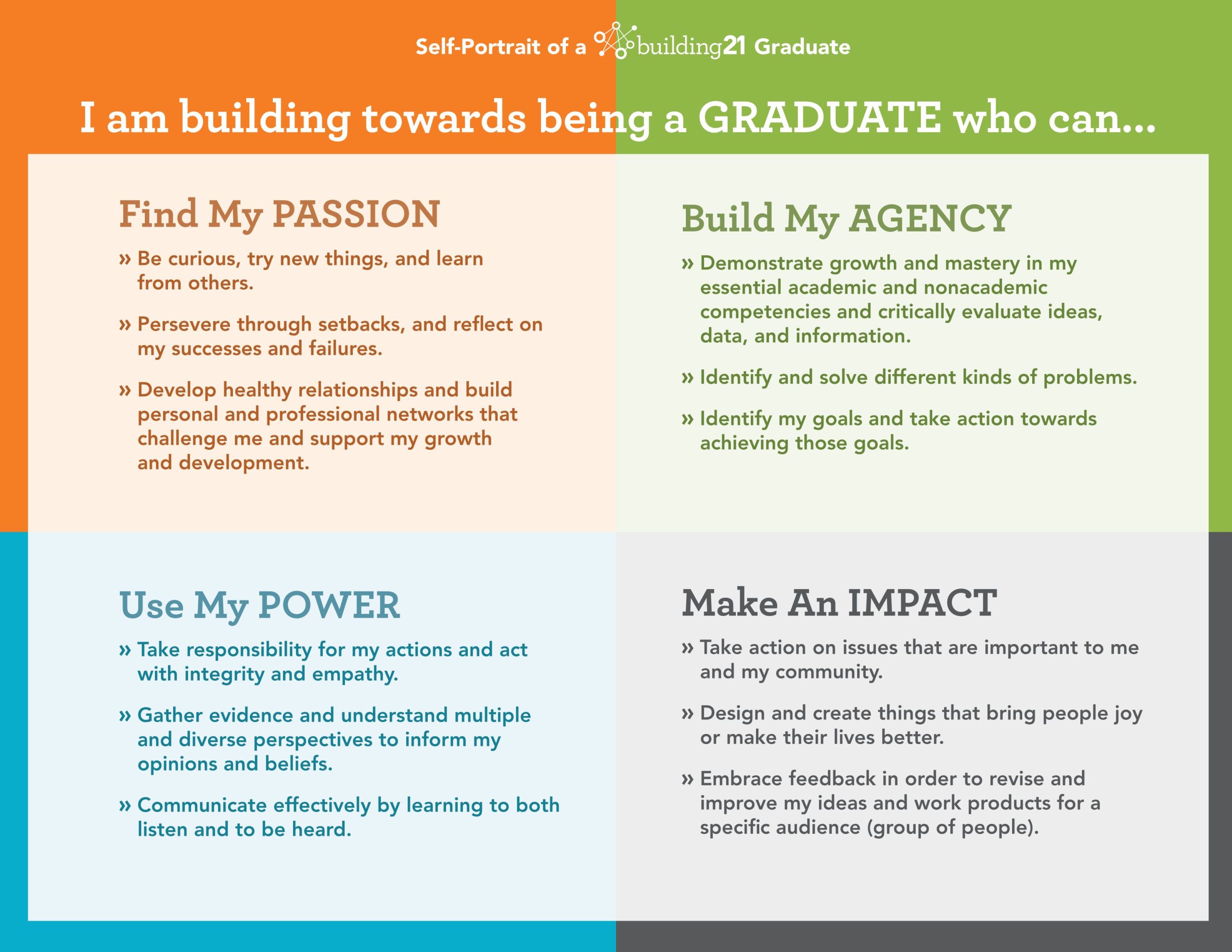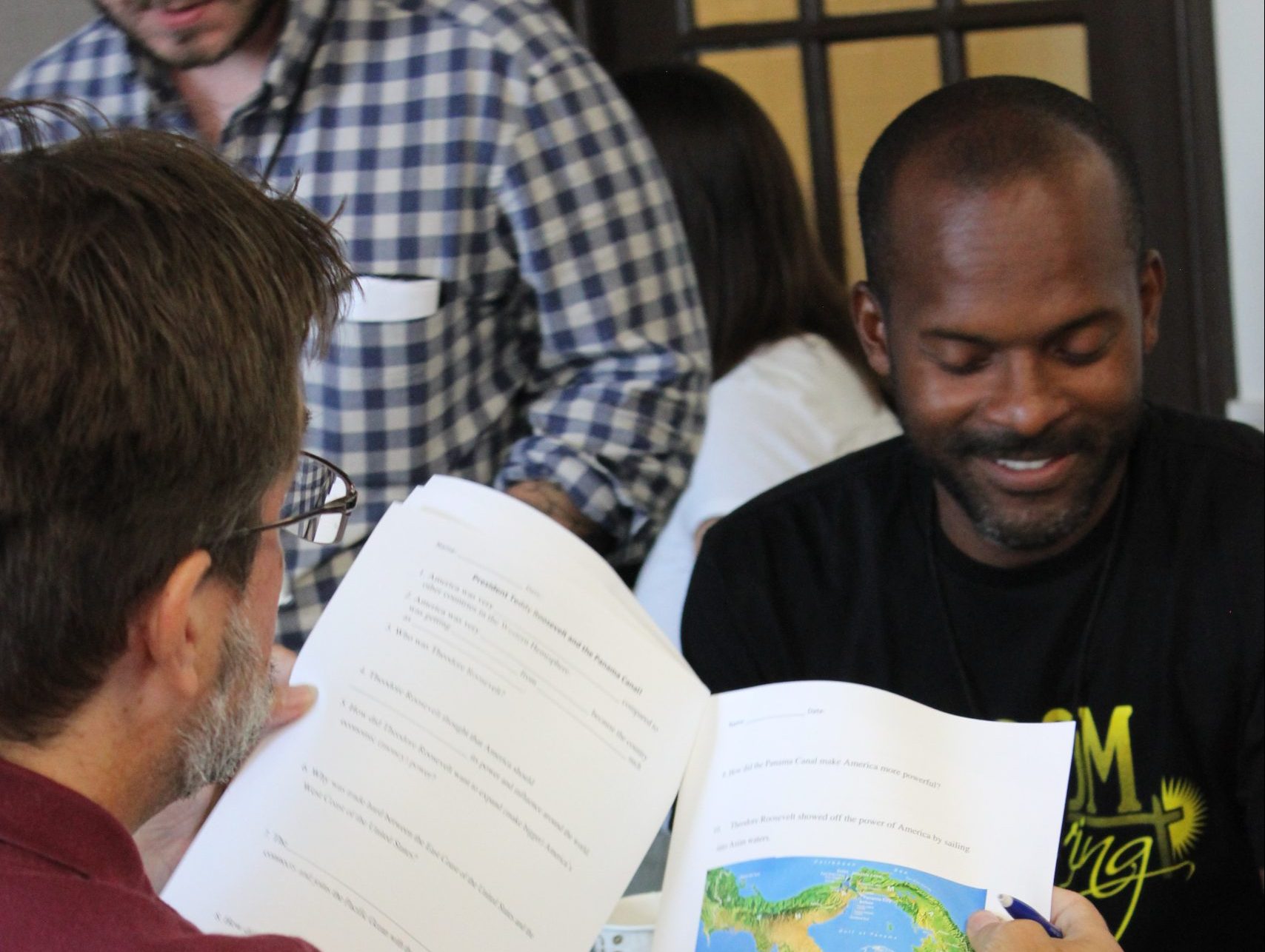Our curriculum work begins with our Self-Portrait of a Building 21 Graduate – an overview of the competencies, skills, and character traits our graduates will have as they begin their post-secondary journey. We believe in a whole child approach to education and we provide a curriculum that is rooted in preparing our young people for a world that awaits their contributions and impact. We highlight the components of our theory of action — passion, agency, power, and impact — these are our ultimate aspirations for our students.

With this as our north star, it is then our challenge to make this come to life for our students. Using our competency framework, we must carefully map out all the opportunities our students have to demonstrate and master the competencies, skills, and mindsets we call out in our portrait of a graduate. If we say that our students will build their agency by demonstrating growth and mastery in essential academic and nonacademic competencies, then we better be sure we provide ample opportunities for them to do just this.
So how do we ensure that we create opportunities to find passion, build agency, use power, and make an impact every year, throughout each day, and within each studio? Enter the Building 21 Curriculum Design Team.
After a robust research process to determine how we get our lab schools from Good to Great, we developed a design team to focus on ELA (English Language Arts) and SS (Social Studies) studio design. Twelve veteran teachers from our Philadelphia and Allentown lab schools make up our Building 21 Curriculum Design team: Heather Harlen, Victoria Beers, Samuel Raup, Shannon Salter, Megan Justice, Emily Wilkomm, Sara Grieb, Jared McElroy, Eric Hitchner, Ross Hamilton, Jill Thomas, Shannon Roberts, and Elizabeth Maxwell.
We have charged them with answering this question and, through their work, helping to build coherence and high-quality curriculum across our network of schools. Working in our lab schools gives this team direct lines of sight into what works well and what is challenging about competency-based and personalized learning. They set out to help further strengthen our curriculum framework, focusing on studio design and the guidance teachers need for facilitating instruction.
As we have grown and learned from our teachers’ and students’ experiences, we have developed the pieces of what is now our curriculum framework.

This framework includes the evidence requirements, the number of times each competency is assessed/rated for a student; the opportunity roadmap, the map of all opportunities students have to demonstrate mastery for each competency; and the curriculum overview, a snapshot of curricular essentials to be covered during a student’s four-year journey at Building 21. Over the past several years, the Network team has developed these components of the framework for our lab schools.
Our curriculum designers now set out to articulate and develop the last two pieces of the framework. As experts in their respective content areas, they are working both within content specific teams and across disciplines to revise and finalize studio guides, milestones, stepping stones, and culminating performance tasks. They are also building Google sites to organize the materials, texts, links, and resources each studio requires. This work is invaluable in creating continuity and consistency across studios in our lab schools. With these high-quality guides in place, our school leaders and teachers can ensure that all students have rigorous and consistent opportunities to demonstrate their competencies and engage in projects that allow them to make an impact.
At Building 21, we are devoted to reflection, learning and growth.
A critical part of the design process is to take a step back and reflect on our progress. We do this two times throughout the design process— in December and in May. After implementing Studio Guide 1, we gathered feedback from both designers and the teachers implementing SS and ELA. We asked teachers to provide their feedback on curriculum designs and the curriculum implementation process. We shared that we would share their feedback with individuals at the network level and with curriculum designers to support in the next iteration of studio guides.
After analyzing and sharing data with designers, we made the following adjustments to the design process:
- Reorganize studio guide for simplicity, remove unnecessary components, make more coherent and evident of backwards design.
- Provide designers with an exemplar studio guide template to work from.
- Include a pacing guide that shows timelines across stepping stones and milestones and areas in the curriculum where teachers have autonomy to modify and/or remove or add lessons.
- Provide a variety of texts with text levels in the text section for teachers to pull from.
- Provide more specific support on strategies to support low-level learners.
Ayris Sanders, Building 21’s Director of Lab Schools reflects: “Leading the design work for ELA and SS has been some of the most challenging, rigorous and impactful work that I have ever done. The level of detail, critical thinking, time and care that it takes to truly design a product that is project-based, competency-based, culturally relevant, engaging and prepares our students to 21st century college and career-ready skills is a robust process. I spend hours and hours day in and day out looking closely at designs, supporting teachers, providing professional development and co-writing material. I have also learned that this process is fluid and requires a great deal of flexibility, collaboration, ongoing professional development and modeling. Not only has this been a huge undertaking as the lead, designers are tasked with designing curricula during the school year where they are already planning, teaching, rating and navigating the challenges of the pandemic in their school. I am truly working with superheroes and I thank them for their ongoing commitment and support with such transformational work for students.”
To learn more about Building 21’s curriculum work and Lab Schools, visit our Lab Schools page or contact Ayris Sanders (ayris@b-21.org).
Check out some of Building 21’s curriculum resources here.



